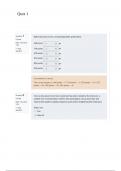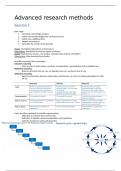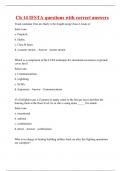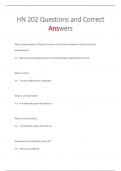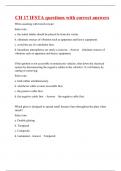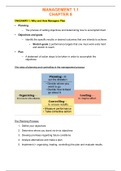Lecture Notes: 3.6 Neuropsychology
,Lecture I
1. To learn the organisation of the brain and the brain anatomy of the parietal and occipital
lobe + basal ganglia
2. To understand how motion and perception are processed in the brain
3. To link lesions of the parietal and occipital lobes to motion and perception disorders
Pointers from the book:
- will not ask about specific animal experiments in the exam; don’t focus too much on
the details
- Brodman areas will not be tested – no Brodman area numbers
- focus on function of the brain instead of neuroanatomical perspective
- focus on the disorders that go with these functions
- beware of legends in pictures in the literature
Þ Neuropsychology
o a branch of psychology – the study of the brain mechanisms in relation to cognitive
and behavioural processes
Þ neurological damage – brain damage provides insights
o vascular disorders (stroke) à sudden oset cerebrovascular events
• cerebral haemorrhage – bleeding in the brain
• cerebral ischemia – disruption of blood supply (thrombosis, embolism,
arteriosclerosis)
o tumours – a mass of cells, which grows independently of the rest of the body
o trauma – injuries of the brain (close- and open-head)
• traffic accidents, sporting accidents
o epilepsy – excessive and abnormal pattern of activity in the brain, it induces a transient
lost of consciousness
o degenerative disorders – entails the death of neurons, motor or cognitive difficulties
often notices by family members
• Parkinson: degeneration of the basal ganglia, resulting in a reduction of the
dopamine and difficulties in initiating a behavior
• Alzheimer disease: degeneration of the neurons in the cortex, characterized by
attentional deficits, forgiveness, changes in personality,
• Huntington disease: genetic disease, which involves atrophy of the striatum. It
first impairs motoric abilities and afterwards cognitive processes
• Korsakoff disease: degeneration of the diencephalon, mainly due to chronic
alcoholism and malnutrition, it produces amnesia
• Multiple sclerosis: degeneration of the myelin surrounding the axons, which can
lead to degeneration of the neuron itself, it is an autoimmune disorder
Þ research methods
o psychophysiological indices – measure the peripheral responses – EDA, EMG, ECG
o imaging techniques – measure brain activation – EEG, fMRI, MRI, PET
Þ EDA – measure the activation of the sympathetic system meaning the physiological arousal
(activation) necessary to initiate a behavioural response
o EDA is larger to both positive and negative pictures as compared to neutral ones
Þ EEG – measures the electrical signal originating from the pyramidal cells, which
has a negative charge
, o when numerous pyramidal cells are activated synchronically, we can detect relatively
large waves on the scalp (event-related potentials ERPs)
o measure it in a non-evasive way
Þ fMRI – measures the metabolic signal orienting from the blood oxygen level
o blood-oxygen level-dependent (BOLD) signal is an indirect index of neural activation
o only secondary measure of brain function
• measure the vascular or the blood response to certain brain activations so it’s not
brain activation itself but it’s the energy, oxygen transported
• can measure only slow responses, cannot look at fast-changing activations
Þ anatomical organisation
o Rostral/Anterior à parts of the body toward the nose
o Caudal/Posterior à parts of the body toward the tail
o Dorsal à parts of the body pointing up from the back
o Ventral à parts of the body pointing down from the belly
o Medial à structures close to the midline
o Lateral à structures far from the midline
• Ipsilateral: structures on the same side of the body
• Contralateral: structures on the opposite side of the body
Þ 3 different ways of viewing
o sagital – cut in the middle
o coronal – from one year to the other
o axial
Þ NS
o CNS – spinal cord, brain
o PNS – somatic nervous system, autonomic nervous system
• SNS: controlling all senses, how the information is transferred to the
brain
• ANS: control how our body functions – heart rate, respiration,
digestion
Þ brain
o myelencephalon (or medulla) – connects the brain with the spinal cord
o Metencephalon (or hindbrain) – consists of pons and cerebellum, somatosensory
structure
o Mesencephalon (or midbrain) – consists of tegmentum, periaqueductal grey (PAG),
visuomotor structure
o Diencephalon – consists of hypothalamus and thalamus, referred as “gateway to the
cortex”
o telencephalon – consists of the cerebral cortex (i.e., neocortex) and sub-cortical
structures (i.e., basal ganglia, limbic system)
• most important part for the humans
• basal ganglia – motor control
o 4 ventricles (hollow spaces) – filled with cerebrospinal fluid
• reduce brain shock caused by sudden movements of the head
• prevent damage
,Lecture I
1. To learn the organisation of the brain and the brain anatomy of the parietal and occipital
lobe + basal ganglia
2. To understand how motion and perception are processed in the brain
3. To link lesions of the parietal and occipital lobes to motion and perception disorders
Pointers from the book:
- will not ask about specific animal experiments in the exam; don’t focus too much on
the details
- Brodman areas will not be tested – no Brodman area numbers
- focus on function of the brain instead of neuroanatomical perspective
- focus on the disorders that go with these functions
- beware of legends in pictures in the literature
Þ Neuropsychology
o a branch of psychology – the study of the brain mechanisms in relation to cognitive
and behavioural processes
Þ neurological damage – brain damage provides insights
o vascular disorders (stroke) à sudden oset cerebrovascular events
• cerebral haemorrhage – bleeding in the brain
• cerebral ischemia – disruption of blood supply (thrombosis, embolism,
arteriosclerosis)
o tumours – a mass of cells, which grows independently of the rest of the body
o trauma – injuries of the brain (close- and open-head)
• traffic accidents, sporting accidents
o epilepsy – excessive and abnormal pattern of activity in the brain, it induces a transient
lost of consciousness
o degenerative disorders – entails the death of neurons, motor or cognitive difficulties
often notices by family members
• Parkinson: degeneration of the basal ganglia, resulting in a reduction of the
dopamine and difficulties in initiating a behavior
• Alzheimer disease: degeneration of the neurons in the cortex, characterized by
attentional deficits, forgiveness, changes in personality,
• Huntington disease: genetic disease, which involves atrophy of the striatum. It
first impairs motoric abilities and afterwards cognitive processes
• Korsakoff disease: degeneration of the diencephalon, mainly due to chronic
alcoholism and malnutrition, it produces amnesia
• Multiple sclerosis: degeneration of the myelin surrounding the axons, which can
lead to degeneration of the neuron itself, it is an autoimmune disorder
Þ research methods
o psychophysiological indices – measure the peripheral responses – EDA, EMG, ECG
o imaging techniques – measure brain activation – EEG, fMRI, MRI, PET
Þ EDA – measure the activation of the sympathetic system meaning the physiological arousal
(activation) necessary to initiate a behavioural response
o EDA is larger to both positive and negative pictures as compared to neutral ones
Þ EEG – measures the electrical signal originating from the pyramidal cells, which
has a negative charge
, o when numerous pyramidal cells are activated synchronically, we can detect relatively
large waves on the scalp (event-related potentials ERPs)
o measure it in a non-evasive way
Þ fMRI – measures the metabolic signal orienting from the blood oxygen level
o blood-oxygen level-dependent (BOLD) signal is an indirect index of neural activation
o only secondary measure of brain function
• measure the vascular or the blood response to certain brain activations so it’s not
brain activation itself but it’s the energy, oxygen transported
• can measure only slow responses, cannot look at fast-changing activations
Þ anatomical organisation
o Rostral/Anterior à parts of the body toward the nose
o Caudal/Posterior à parts of the body toward the tail
o Dorsal à parts of the body pointing up from the back
o Ventral à parts of the body pointing down from the belly
o Medial à structures close to the midline
o Lateral à structures far from the midline
• Ipsilateral: structures on the same side of the body
• Contralateral: structures on the opposite side of the body
Þ 3 different ways of viewing
o sagital – cut in the middle
o coronal – from one year to the other
o axial
Þ NS
o CNS – spinal cord, brain
o PNS – somatic nervous system, autonomic nervous system
• SNS: controlling all senses, how the information is transferred to the
brain
• ANS: control how our body functions – heart rate, respiration,
digestion
Þ brain
o myelencephalon (or medulla) – connects the brain with the spinal cord
o Metencephalon (or hindbrain) – consists of pons and cerebellum, somatosensory
structure
o Mesencephalon (or midbrain) – consists of tegmentum, periaqueductal grey (PAG),
visuomotor structure
o Diencephalon – consists of hypothalamus and thalamus, referred as “gateway to the
cortex”
o telencephalon – consists of the cerebral cortex (i.e., neocortex) and sub-cortical
structures (i.e., basal ganglia, limbic system)
• most important part for the humans
• basal ganglia – motor control
o 4 ventricles (hollow spaces) – filled with cerebrospinal fluid
• reduce brain shock caused by sudden movements of the head
• prevent damage


